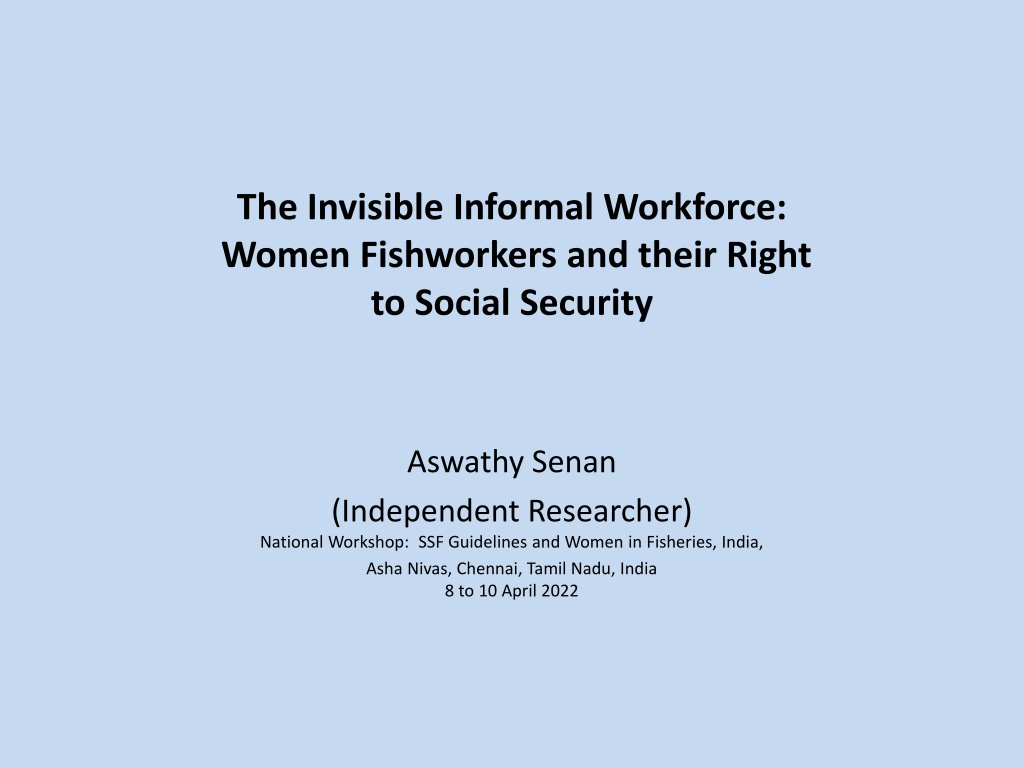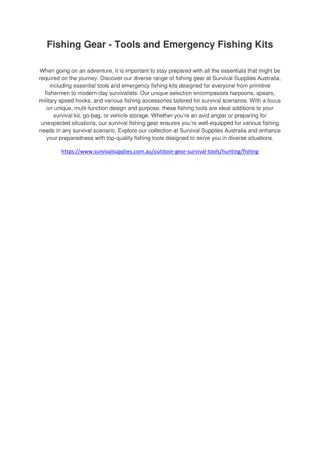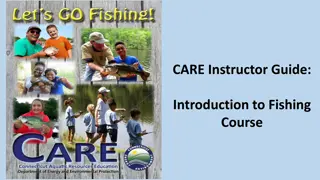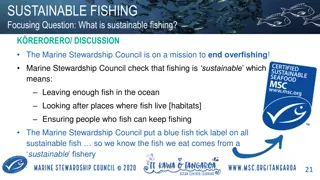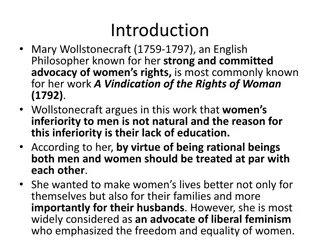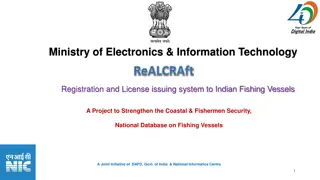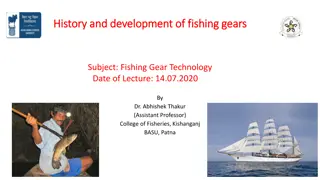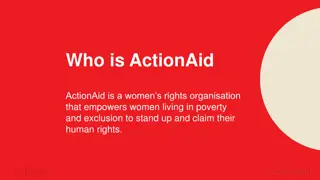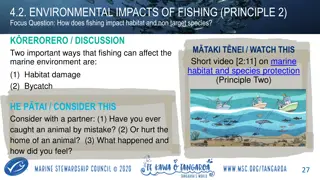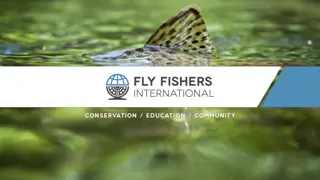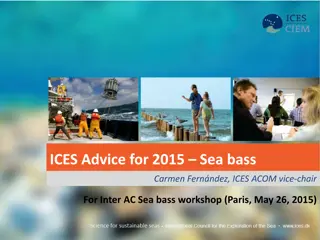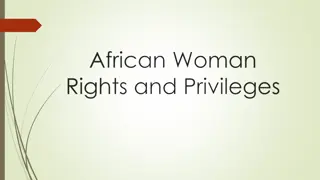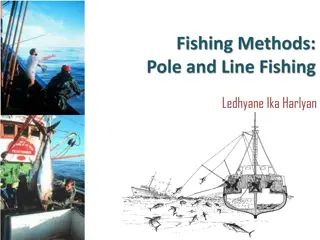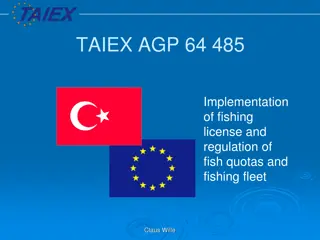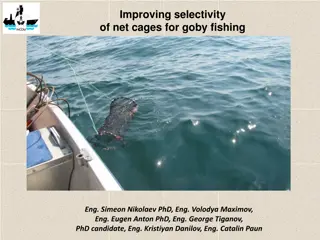Women Fishworkers in India: Challenges and Rights in the Fishing Industry
Women fishworkers in India face invisibility, lack of recognition, being unheard, and underpaid in the fishing industry. Despite their significant contribution to activities related to fishing, they struggle for social security and face challenges in accessing welfare schemes. The marine fisheries sector witnesses a gender imbalance with 56% of fisher population being women. This article sheds light on the traditional occupation of fisheries, the role of women in fish production, and the genderwise distribution of fisherfolk population in Tamil Nadu.
Download Presentation

Please find below an Image/Link to download the presentation.
The content on the website is provided AS IS for your information and personal use only. It may not be sold, licensed, or shared on other websites without obtaining consent from the author. Download presentation by click this link. If you encounter any issues during the download, it is possible that the publisher has removed the file from their server.
E N D
Presentation Transcript
The Invisible Informal Workforce: Women Fishworkers and their Right to Social Security Aswathy Senan (Independent Researcher) National Workshop: SSF Guidelines and Women in Fisheries, India, Asha Nivas, Chennai, Tamil Nadu, India 8 to 10 April 2022
Duties/Activities Fisher (Workspace/Domestic) Worker (Formal/Informal) Woman (Domestic/Workspace)
What does it mean to be a woman fishworker in India? Invisible Unrecognised Unheard Underpaid
Fish production: 7.75 lakh tonnes in 2019 The total fisher population of India in 2019-20 is 2,80,63,537 (marine and inland): 56 per cent is women. Women fishworkers: Allied activities with regard to fishing: marketing of fish, making/repairing net, labour (labourer includes head load workers, helpers etc. at the landing centres) and other fishing associated roles in the sector such as auctioneers, ice breakers, members involved in collection of bivalves, other shells, seaweed, ornamental fish, etc. (Welfare schemes applicable to all these factors are available across various boards)
Fisheries: A traditional occupation, with members of the community involved either in the harvesting or pre and post harvesting activity. Over the years: Production increasingly oriented towards export and upmarket, capital technology build up, changes in social attitudes, work ethics, labour patterns, government policies and increasing competitions Marine fisherman : a person who is engaged in marine fishing or any other activity associated with marine fishery or both (A person here means a man or a woman) ; traditional fishermen as those who are fishermen by birth and fishing is their ancestral occupation and fishermen family as a family in which at least one member is engaged in marine fishing or associated activities or both. fishers of which 56 per cent is women. - The Marine Fisheries Census 2010
Category Men Women Population of Fisherfolk 535,337 512,500 Population engaged in Marine Fisheries activities Fulltime 208,201 NA Part Time 24,253 201,286 Occasional 12,815 17,645 Unspecified 65,170 248,663 Deep Sea 25,000 NA Table 1: Genderwise fisherfolk population in Tamil Nadu: 2019-20; Source: The Handbook of FisheriesStatistics (2010)
Informal economy: All economic activities by workers and economic units that are in law or in practice not covered or insufficiently covered by formal arrangements. Their activities are not included in the law, which means that they are operating outside the formal reach of the law; or they are not covered in practice, which means that although they are operating within the formal reach of the law, the law is not applied or not enforced; or the law discourages compliance because it is inappropriate, burdensome, or imposes excessive costs. - Decent Work and the Informal Economy (ILO 2002) Social security: The measures of protection afforded to employees, unorganised workers, gig workers and platform workers to ensure access to health care and to provide income security, particularly in cases of old age, unemployment, sickness, invalidity, work injury, maternity or loss of a breadwinner by means of rights conferred on them and schemes framed, under this Code. - The Code on Social Security passed by the Indian Parliament (Sept 2020)
Recognise fishing as productive work in which rights are protected, which generates an adequate income, with adequate social protection. Fishers ordinarily resident in its territory, and their dependants to the extent provided in national law, are entitled to benefit from social security protection under conditions no less favourable than those applicable to other workers, including employed and self-employed persons, ordinarily resident in its territory. - ILO Convention 188 (C-188) passed on 14 June 2007 Social security: The protection that a society provides to individuals and households to ensure access to health care and to guarantee income security, particularly in cases of old age, unemployment, sickness, invalidity, work injury, maternity or loss of a breadwinner and contribute to social cohesion and to a country s overall growth and development by bolstering living standards, cushioning the effects of structural and technological change on people - ILO
9 June 2008: The State level seminar on ILO Convention on work in fishing Tamil Nadu held in Chennai participated by 85 people representing fishing community leaders, trade unions, social activists, intellectuals, media persons and students. Recommendations: Fisher peoples organizations, trade unions, civil society organizations, NGOs conduct intensive campaign for ratification of the ILO Convention on fishing by the Government of India and enactment of a comprehensive national legislation, extending the convention, to cover all fish workers and proposed that the legislation must contain the following provisions: Social security should be the corner stone of the proposed legislation. It should include all sections of fish workers namely the fishers, fish sorters, fish vendors, loaders, fish processing workers; Emphasize social security to all women fish workers together with the men; Legislation should protect and ensure fisher peoples right to access fishery resources; Ensure protection of livelihood of traditional fishers together with conservation of fishery related natural resources; Health protection and education should get top priority and be made a justice able right of the fish workers.
In countries like India, social security is best understood as pro- poor measures that can be: a) promotional, aiming to augment income, such as through the Mahatma Gandhi National Rural Employment Guarantee Act (MGNREGA); b) preventive, aiming to forestall economic distress, such as through Provident Funds (PF); and c) protective, aiming to ensure relief from certain external shocks, such insurance schemes in the case of injury or death of a primary breadwinner
Possibilities of collectivising Unions NGOs SHGs Collectives Cooperatives
Fisheries Department (TN)s mission: To provide fishermen, a safe and secured environment with enhanced livelihood opportunities To ensure social security and quality life for fishermen through multifarious developmental and welfare schemes To safeguard the traditional fishing rights of fishermen To create fisheries infrastructure facilities on par with international standards Tamil Nadu Fisheries Development Corporation Limited (TNFDC) Tamil Nadu State Apex Fisheries Co-operative Federation Limited (TAFCOFED) Tamil Nadu Fishermen Welfare Board (TNFWB)
Membership in the Cooperative is mandatory for availing the welfare schemes which are regulatory, supportive and facilitative. The procedure for joining as a member in a Fisheries Cooperative Society is the following: Any Person in the age group of 18 to 60 who is engaged in fishing activity. The Person should be residing in the area of operation of the society. The person should pay Rs.10/- towards share capital and Rs.1/- as entrance fees in the society The Fisherwomen Co-operative society may also be registered in the area where the fishermen society is functioning
Popular schemes Name of the Scheme 2016-17 2017-18 2018-19 2019-2020 2020-21 Amount Sanction ed // spent Beneficiaries Amount Sanctioned // spent Beneficiari es Amount Sanctioned // spent Beneficiaries Amount Sanctioned // spent Beneficiari es AmountSanc tioned // spent Beneficiaries State Saving- cum-Relief Scheme (SFSRS) for Marine Fisherwomen 36.36 cr // 35.81 Cr 1,98,944(Rs. 4500/- each) 59.65 cr //59.63 Cr 1,98,783 59.65 cr sanctioned and disbursed 1,98,894 61.31 Cr// 41.26 Cr 1,37,524 60.32 Cr spent 2,01,084 Fishing ban period Assistance 83.17 cr 1,53, 124 families (Rs 2000/- each) 79.75 cr (dispersed) 1,59,506 families (Rs. 5000/-) 83.50 cr // 58.55 cr 1,17,115 81.75 Cr (credited) 1,63,491 85.54 Cr disbursed 1,71,076 // 30.62 cr Families families Fishing Lean Period Assistance 82.50 cr // 77.70 cr 1,55,403 families 69.52 cr (dispersed) 1,39,045 82.50 cr // 81.05 cr 1,62,101 88.41 Cr // 65.07 Cr 1,30,133 87.26 Cr disbursed 1,74,529 Families families
Other schemes i. ii. iii. iv. v. Department of Fisheries: Housing: Build a House only for Fisherman community (Central and state schemes) Group Accident Insurance for Active Fishermen Fish rearing and Ornamental Fish Welfare schemes: Relief, education, health, maternity, marriage, accident, death. Fish marketing, transportation and kitchens Health department: Pregnant women, young mothers, infants and children s health (Janani Shishu Suraksha Karyakram (JSSK), Chief Minister s Comprehensive Health Insurance Scheme (Govt of TN through United India Insurance Company Ltd) ) Social Welfare Department: Girl child, orphans, marriage, service homes, hostels, violence and domestic abuse survivors (Chief Minister s Girl Child Protection Scheme, PT MGR- Nutritious Meal Programme) Labour Welfare Board: Computer training, book assistance, child care, etc. (Child Care Center) Education department: nutrition, transportation, hostel, uniform, teaching material) TN Disaster Management Authority: Relief and rehabilitation (Health and mental health care) Rural Development and Panchayat Raj: Cleanliness, housing schemes (Pradhan Mantri Awas Yojana Urban) Revenue Administration and Disaster Management: Pension (widow, disabled)
Challenges Dormant membership in the cooperatives Stagnant membership in the cooperatives Stagnant membership in the cooperatives Responsibility of care work Inability to pursue higher studies Lack of information and initiative Lack of documents Excessive bureaucracy Gender disparity in accessing welfare Domination of men in the functioning of the collectives
2016-17 2017-18 2018-19 2019-2020 2020-21 Society/Board No of Societies Members Enrolled No of Societies Members Enrolled No of Societie s Member s Enrolled No of Societie s Member s Enrolled No of Societie s Member s Enrolled Marine Fisherwomen Co- operative Societies 460 2,50,276 461 2,60,732 461 2,60,73 2 461 2,60,73 2 461 2,60,73 2 Inland Fisherwomen Co-operative Societies 71 8,009 72 7,883 72 7883 72 7883 72 7883 Tamil Nadu Fishermen Welfare Board 4.47 lakh fishermen / fisherwom en 4.50 lakh fishermen / fisherwom en 4.65 lakh member s 4.82 lakh member s 4.70 lakh member s
Possibilities Strengthening of the Cooperatives Making the Thalaivi position of the Cooperatives paid and rotational Dissemination of information about the various schemes Recognition of women as Fishworkers More welfare schemes targeting women and publicising it as so Safe and secure markets Institution of a grievance redressal body Sanitation facilities within markets Applying to schemes from other departments/ministries Systematic updation of the members: Encourage usage of banking among women Improve transportation facilities Set minimum floor price and fair wage
